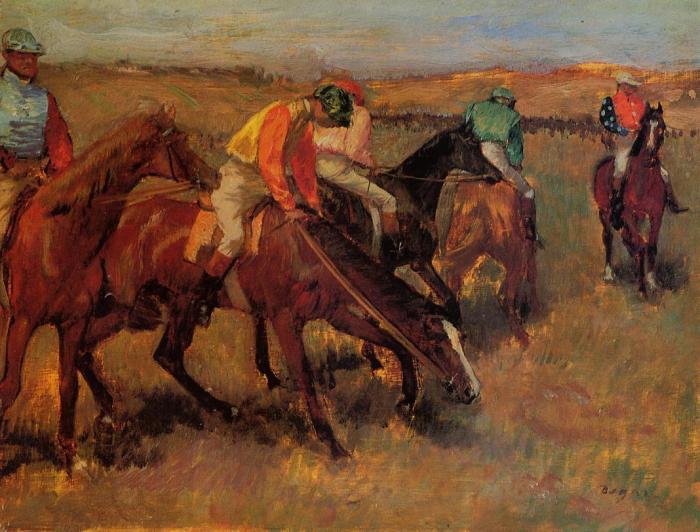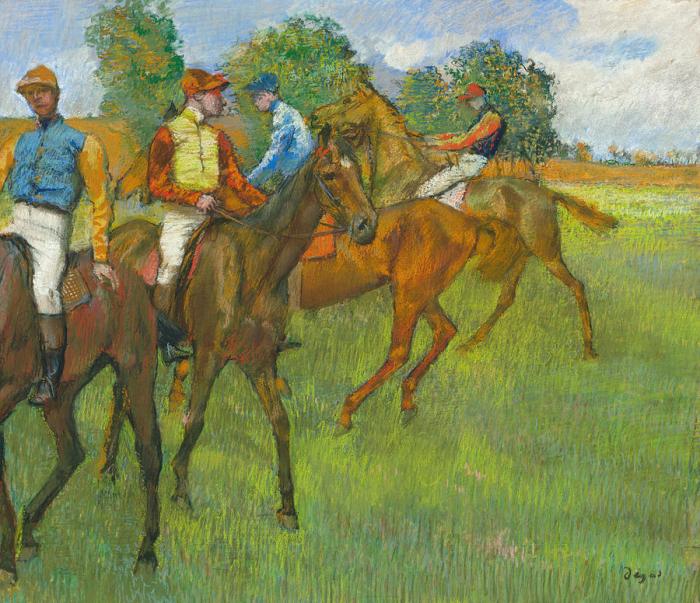Jockeys Before the Race by Edgar Degas is a renowned painting that captures the anticipation and uncertainty of the moments before a horse race. Through its unique composition and masterful use of brushstrokes, Degas conveys the tension and excitement of the jockeys as they prepare for the competition.
Degas’s use of color and light creates a dynamic atmosphere, while the influence of Japanese prints is evident in the painting’s flattened perspective and bold lines. The jockeys’ colorful silks symbolize their roles and the anticipation of the race, while the juxtaposition of their anticipation and the uncertainty of the outcome adds to the painting’s captivating quality.
Composition and Technique

Degas’s “Jockeys Before the Race” features a unique composition that captures the anticipation and excitement of the moment before a race. The painting is set at a racecourse, with the jockeys lined up in the foreground and the track stretching out behind them.
The viewer is positioned at a low angle, looking up at the jockeys as they prepare for the race. This perspective creates a sense of intimacy and immediacy, drawing the viewer into the scene.
Degas uses bold brushstrokes and vibrant colors to convey the movement and atmosphere of the racecourse. The jockeys’ silks are painted in a flurry of bright colors, creating a sense of energy and excitement. The horses are depicted in mid-stride, their muscles rippling beneath their skin.
The background is a blur of color and movement, suggesting the hustle and bustle of the racecourse.
Degas was influenced by Japanese prints, which can be seen in the painting’s flat, two-dimensional composition and the use of bold, graphic lines. This influence gives the painting a sense of dynamism and energy, capturing the fleeting moment of anticipation before the race begins.
Subject Matter and Symbolism

The jockeys depicted in the painting are professional riders who compete in horse races. In 19th-century France, horse racing was a popular sport that attracted large crowds and high stakes. The jockeys’ colorful silks represent the different stables they ride for.
The juxtaposition of their anticipation and the uncertainty of the race creates a sense of tension and excitement.
The painting also explores the symbolism of the horse race. The horses are symbols of power and speed, while the jockeys represent the human desire to control and conquer nature. The race itself is a metaphor for the challenges and uncertainties of life.
Historical and Cultural Context: Jockeys Before The Race By Edgar Degas

“Jockeys Before the Race” is part of Degas’s larger body of work that depicts scenes from everyday life. The painting reflects the artist’s interest in capturing the fleeting moments of human experience. It is also a product of the Impressionist movement, which emphasized the importance of light and atmosphere in painting.
Horse racing was a popular pastime in 19th-century France, and Degas’s painting captures the excitement and anticipation of the sport. The painting also reflects the social and cultural significance of horse racing in France during the period.
Technical Analysis
Comparison of “Jockeys Before the Race” and “The Star” by Edgar Degas
| Jockeys Before the Race | The Star | |
|---|---|---|
| Composition | Dynamic arrangement of jockeys lined up in the foreground, with the track stretching out behind them. | Single figure of a ballerina on stage, surrounded by a dark background. |
| Brushwork | Bold, expressive brushstrokes that convey movement and atmosphere. | Delicate, precise brushstrokes that capture the grace and beauty of the dancer. |
| Color Palette | Vibrant colors, particularly in the jockeys’ silks. | Subtle, muted colors, with a focus on light and shadow. |
| Subject Matter | Jockeys preparing for a race. | A ballerina performing on stage. |
Steps in Degas’s Creative Process
- Sketching: Degas would often begin by making quick sketches of his subjects.
- Color studies: He would then experiment with different color combinations to create the desired atmosphere.
- Underpainting: Degas would apply a thin layer of paint to the canvas to establish the basic composition.
- Final execution: He would then work on the painting in layers, gradually building up the forms and details.
Dimensions, Materials, and Location
- Dimensions: 85.7 x 111.8 cm
- Materials: Oil on canvas
- Location: Musée d’Orsay, Paris
Popular Questions
Who are the jockeys depicted in the painting?
The jockeys depicted in the painting are not specifically identified, but they represent the various jockeys who participated in horse races in 19th-century France.
What is the significance of horse racing in the painting?
Horse racing was a popular and prestigious sport in 19th-century France, and Degas’s painting captures the excitement and anticipation of the race.
How does Degas convey the tension and excitement of the moment before the race?
Degas conveys the tension and excitement of the moment before the race through his use of dynamic brushstrokes, vibrant colors, and the juxtaposition of the jockeys’ anticipation and the uncertainty of the outcome.